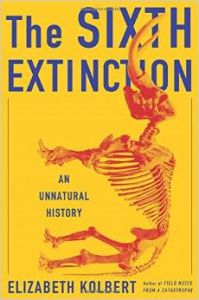Rats! Is there a real possibility that rats may be the species that survives the human race? Elizabeth Kolbert suggests such an outcome in her engrossing perambulation around this modest earth on which we live, since we may well be living at the start of the “Sixth Extinction.”
Science tells us the earth has experienced five earlier “extinctions,” when many living creatures, small and large, disappeared because of a major change in the earth’s constitution or because of an errant asteroid. But these five occurred approximately 450, 375, 250, 200 and 60 million years ago, in a universe that is 13.5 billion years old.
So we are minute upstarts on this planet. But, as a thinking and intensely curious species, we’ve tried to understand that long past, plus our present and a most uncertain future.
Kolbert’s question: are we creating our own Sixth Extinction?
Like Pogo, she suggests “the cataclysm is us!” “Since the start of the industrial revolution,” she writes, “humans have burned through enough fossil fuels—coal, oil, and natural gas—to add some 365 billion metric tons of carbon to the atmosphere. Deforestation has contributed another 180 billion tons. Each year we throw up another nine billion tons or so . . . . The concentration of carbon dioxide in the air today . . . is higher than at any other point in the last eight hundred thousand years. . . . It is expected that such an increase will produce an eventual average global temperature rise of between three and a half and seven degrees Fahrenheit . . . (triggering) the disappearance of most remaining glaciers, the inundation of low-lying islands and coastal cities, and the melting of the Arctic ice cap.”
Then add to that “ocean acidification.”
We know that all species on this planet are interdependent, but are humans also an “invasive species?” Yes, we seem to be collective problem solvers (much like ants, according to E. O. Wilson) but we seem to be unable to solve our biggest problem: us! “Though it might be nice to imagine there was once a time when men lived in harmony with nature, it is not clear he ever did!”
Is it possible, then, as Kolbert suggests, “ . . . a hushed hundred million years from now, all that we consider to be the great works of man – the sculptures and the libraries, the monuments and the museums, the cities and the factories – will all be compressed into a layer of sediment not much thicker than a cigarette paper?”
Kolbert visits locations all around this earth – some 11 countries – very much like Alan Weisman’s research for his Countdown, exploring current rates of extinction. One is on an island in the Great Barrier Reef of Australia, looking at the erosion of coral. Another is the decline of bats in the eastern United States. Still another is the Panamanian golden frog. Together, she says, they indicate we are a part of the Anthropocene epoch, during which we may well become extinct.
This is a sobering analysis of current practices and signs. She acknowledges the possibility that “human ingenuity will outrun any disaster that human ingenuity sets in motion.” But I’m left with the likelihood that our friend the rat, who has hitchhiked to almost every piece of this earth with us, and who successfully scavenges our debris, may survive us. As Ratty pronounced, in Kenneth Grahame’s The Wind in the Willows (my paraphrase), “Believe me, my young friend, there is nothing – absolutely nothing — half so much worth doing as simply messing about with humans.”
Her book is “one of 2014’s best” according to The Economist.
 About the author: Felix Kloman is a sailor, rower, husband, father, grandfather, retired management consultant and, above all, a curious reader and writer. He’s explored how we as human beings and organizations respond to ever-present uncertainty in two books, ‘Mumpsimus Revisited’ (2005) and ‘The Fantods of Risk’ (2008). A 20-year resident of Lyme, he now writes book reviews, mostly of non-fiction that explores our minds, our behavior, our politics and our history. But he does throw in a novel here and there. For more than 50 years, he’s put together the 17 syllables that comprise haiku, the traditional Japanese poetry, and now serves as the self-appointed “poet laureate” of Ashlawn Farms Coffee, where he may be seen on Friday mornings. His wife, Ann, is also a writer, but of mystery novels, all of which begin in a bubbling village in midcoast Maine, strangely reminiscent of the town she and her husband visit every summer.
About the author: Felix Kloman is a sailor, rower, husband, father, grandfather, retired management consultant and, above all, a curious reader and writer. He’s explored how we as human beings and organizations respond to ever-present uncertainty in two books, ‘Mumpsimus Revisited’ (2005) and ‘The Fantods of Risk’ (2008). A 20-year resident of Lyme, he now writes book reviews, mostly of non-fiction that explores our minds, our behavior, our politics and our history. But he does throw in a novel here and there. For more than 50 years, he’s put together the 17 syllables that comprise haiku, the traditional Japanese poetry, and now serves as the self-appointed “poet laureate” of Ashlawn Farms Coffee, where he may be seen on Friday mornings. His wife, Ann, is also a writer, but of mystery novels, all of which begin in a bubbling village in midcoast Maine, strangely reminiscent of the town she and her husband visit every summer.

Frankly, I am not sure how this fits on what is essentially a local news web site. Unique insights on living here locally I think is more what we are about. JW
Jerome: A challenging observation! I have tried to make some connection to the Lymes in several of my reviews. In Robert Macfarlanes “The Old Ways,” I noted my hikes in the Nehantic State Forest, and in the forthcoming review of Richard Ford’s “Let Me Be Frank With You,” I cite an amusing put-down of Deep River. I should have mentioned in my review of “The Sixth Extinction” that I was accosted while reading and sipping a drink on our Lyme porch by a sarcastic mouse, who imperiously advised me that his ilk would far outlast homo sapiens!
But don’t we live now in an increasingly inter-dependent world, where knowledge of what others do and think are important. Let me have your comments on future reviews!